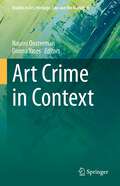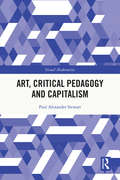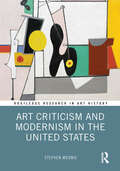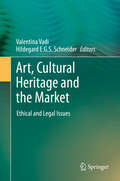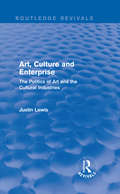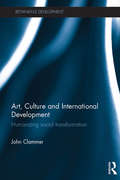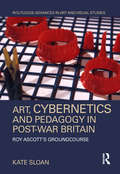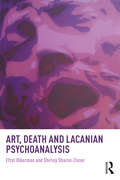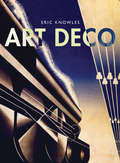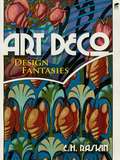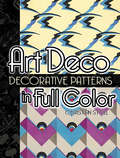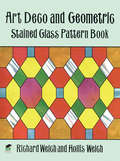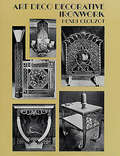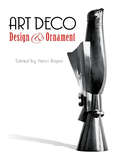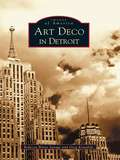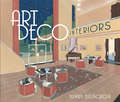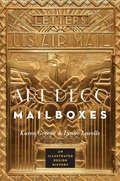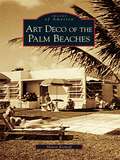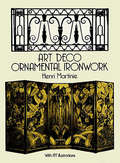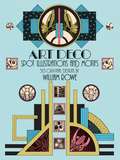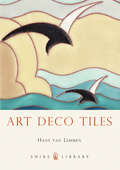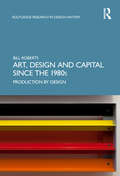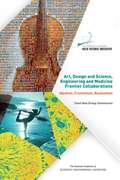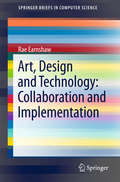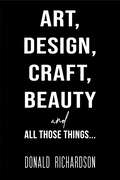- Table View
- List View
Art Crime in Context (Studies in Art, Heritage, Law and the Market #6)
by Donna Yates Naomi OostermanThis book brings together empirical and theoretical case-study research on art and heritage crime. Drawn from a diverse group of researchers and professionals, the work presented explores contemporary conceptualisations of art crime within broader contexts. In this volume, we see ‘art’ in its usual forms for art crime scholarship: in paintings and antiquities. However, we also see art in fossils and in violins, chairs and jewellery, holes in the ground and even in the institutions meant to protect any, or all, of the above. And where there is art, there is crime. Chapters in this volume, alternatively, zoom in on specific objects, on specific locations, and on specific institutions, considering how each interact with the various conceptions of crime that exist in those contexts. This volume challenges the boundaries of what we understand as “art and heritage crimes” and displays that both art, and criminality related to art, is creative and unpredictable.
Art, Critical Pedagogy and Capitalism (Visual Modernities)
by Paul Alexander StewartThis book offers a re-examination of art production in terms that understand the process of learning as the production of art itself. Drawing on the thought of Ranciere, Freire, Gramsci and Mouffe, it provides an account of the politics of art production and a theoretical understanding of hegemonic power, while developing a view of method in critical pedagogy founded on the process of ‘making adversaries’. Through a re-evaluation of the relationships between process, arts production and pedagogy within accelerated developments of neoliberalism, the author uncovers ways of forming a more co-operative and less conflictual approach to democratic politics. An investigation of ways in which art practice can be used to engage with critical pedagogy in relation to a commodity driven neoliberal agenda, Art, Critical Pedagogy and Capitalism constitutes a radical rethinking of art making, and an attempt to address the paradox between the proliferation of the commodity of learning and the perceived crisis of arts education. As such, it will appeal to scholars of education, pedagogy and the arts with interests in social and critical theory.
Art Criticism and Modernism in the United States (Routledge Research in Art History)
by Stephen MoonieThis study is an analysis of 'high' and 'late' modernist criticism in New York during the 1960s and early 1970s. Through a close reading of a selection of key critics of the period—which will expand the remit beyond the canonical texts—the book examines the ways that modernist criticism’s discourse remains of especial disciplinary interest. Despite its alleged narrowness and exclusion, the debates of the 1960s raised fundamental questions concerning the nature of art writing. Those include arguments around the nature of value and judgement; the relationship between art criticism and art history; and the related problem of what we mean by the ‘contemporary.’ Stephen Moonie argues that within those often-fractious debates, there exists a shared discourse. And further, contrary to the current consensus that modernists were elitist, dogmatic, and irrelevant to contemporary debates on art, the study shows that there is much that we can learn from reconsidering their writings. The book will be of interest to scholars working in art history, modern art, art criticism, and literary studies.
Art, Cultural Heritage and the Market: Ethical and Legal Issues
by Valentina Vadi Hildegard E. G. S. SchneiderIn the age of economic globalisation, do art and heritage matter? Once the domain of elitist practitioners and scholars, the governance of cultural heritage and the destiny of iconic artefacts have emerged as the new frontier of international law, making headlines and attracting the varied interests of academics and policy-makers, museum curators and collectors, human rights activists and investment lawyers and artists and economists, just to mention a few. The return of cultural artefacts to their legitimate owners, the recovery of underwater cultural heritage and the protection and promotion of artistic expressions are just some of the pressing issues addressed by this book. Contemporary intersections between art, cultural heritage and the market are complicated by a variety of ethical and legal issues, which often describe complex global relations. Should works of art be treated differently from other goods? What happens if a work of art, currently exhibited in a museum, turns out to have originally been looted? What is the relevant legal framework? What should be done with ancient shipwrecks filled with objects from former colonies? Should such objects be kept by the finders? Should they be returned to the country of origin? This book addresses these different questions while highlighting the complex interplay between legal and ethical issues in the context of cultural governance. The approach is mainly legal but interdisciplinary aspects are considered as well.
Art, Culture and Enterprise: The Politics of Art and the Cultural Industries (Routledge Revivals)
by Justin LewisFirst published in 1990, this investigative overview of the politics of arts’ and cultural funding examines the question of public support for the arts. Looking at both popular commercial forms of culture, including radio, pop music and cinema, and the more traditional highbrow arts such as drama and opera, Art, Culture and Enterprise was the first book of its kind to deal systematically with the politics of contemporary culture. Drawing examples from specific British venues, Justin Lewis shows how innovative projects work in practice, and considers arts marketing and the promotion of culture as an economic strategy. A particularly relevant title in the context of the debate surrounding Arts Council funding, this reissue will prove valuable for artists, administrators and students of media and cultural studies, alongside those with a general interest in the future of public art and culture.
Art, Culture and International Development: Humanizing social transformation (Rethinking Development)
by John ClammerCulture is not simply an explanation of last resort, but is itself a rich, multifaceted and contested concept and set of practices that needs to be expanded, appreciated and applied in fresh ways if it is to be both valued in itself and to be of use in practical development. This innovative book places culture, specifically in the form of the arts, back at the centre of debates in development studies by introducing new ways of conceptualizing art in relation to development. The book shows how the arts and development are related in very practical ways – as means to achieve development goals through visual, dramatic, filmic and craft-inspired ways. It advocates not so much culture and development, but rather for the development of culture. Without a cultural content to economic and social transformation the problems found in much development – up-rooting of cultures, loss of art forms, languages and modes of expression and performance – may only accelerate. Paying attention to the development of the arts as the content of development helps to amend this culturally destructive process. Finally, the book argues for the value of the arts in attaining sustainable cultures, promoting poverty alleviation, encouraging self-empowerment, stimulating creativity and the social imagination, which in turn flow back into wider processes of social transformation. Discussion questions at the end of each chapter make this book ideal to help foster further thinking and debate. This book is an inspiring read for postgraduate students and researchers in the fields of development studies, cultural studies and sociology of development.
Art, Cybernetics and Pedagogy in Post-War Britain: Roy Ascott’s Groundcourse (Routledge Advances in Art and Visual Studies)
by Kate SloanThis is the first full-length study about the British artist Roy Ascott, one of the first cybernetic artists, with a career spanning seven decades to date. The book focuses on his early career, exploring the evolution of his early interests in communication in the context of the rich overlaps between art, science and engineering in Britain during the 1950s and 1960s. The first part of the book looks at Ascott’s training and early work. The second park looks solely at Groundcourse, Ascott’s extraordinary pedagogical model for visual arts and cybernetics which used an integrative and systems-based model, drawing in behaviourism, analogue machines, performance and games. Using hitherto unpublished photographs and documents, this book will establish a more prominent place for cybernetics in post-war British art.
Art, Death and Lacanian Psychoanalysis
by Efrat Biberman Shirley Sharon-ZisserArt, Death and Lacanian Psychoanalysis examines the relationship between art and death from the perspective of Lacanian psychoanalysis. It takes a unique approach to the topic by making explicit reference to the death drive as manifest in theories of art and in artworks. Freud’s treatment of death focuses not on the moment of biological extinction but on the recurrent moments in life which he called "the death drive" or the "compulsion to repeat": the return precisely of what is most unbearable for the subject. Surprisingly, in some of its manifestations, this painful repetition turns out to be invigorating. It is this invigorating repetition that is the main concern of this book, which demonstrates the presence of its manifestations in painting and literature and in the theoretical discourse concerning them from the dawn of Western culture to the present. After unfolding the psychoanalytical and philosophical underpinnings for the return of the death drive as invigorating repetition in the sphere of the arts, the authors examine various aspects of this repetition through the works of Gerhard Richter, Jeff Wall, and contemporary Israeli artists Deganit Berest and Yitzhak Livneh, as well as through the writings of Virginia Woolf and James Joyce. First to articulate the stimulating aspect of the death drive in its relation to the arts and the conception of art as a varied repetition beyond a limit, Art, Death and Lacanian Psychoanalysis will be indispensable to psychoanalysts, scholars of art theory and aesthetics and those studying at the intersection of art and psychoanalysis.
Art Deco
by Eric KnowlesAlthough most associated with the 1920s and 30s, Art Deco began in France prior to World War I. During the interwar years the style evolved and was adopted by an international elite set as the perfect expression of modern opulence and elegance in an age that gave birth to jazz, the Charleston, speakeasies, glamorous Hollywood films and engineering marvels such as skyscrapers. At the height of its popularity the Art Deco influence was seen in a wide variety of remarkable and innovative applications from decorative arts such as jewelry, metalwork, ceramics, and glass to massive scale applications in architecture, interior design, fashion, public works projects and consumer goods from automobiles to telephones to jukeboxes. This unique book is a collection of the most beautiful examples of Art Deco style from personal statements in jewelry to skyscrapers that defined city skylines, and examines the social and cultural climates of the 1920s and 30s which were perfectly aligned with the optimism and elegance of Art Deco. It traces the seminal influences in its evolution including the Ballets Russes, Cubism and the Bauhaus and explains why Art Deco style continues to attract new collectors and enthusiasts who connect with this design styles' impeccable ability to convey opulence, elegance, and exclusivity.
Art Deco: Design Fantasies
by E. H. RaskinDerived from a rare French publication of the 1920s, Fantaisies Oceanographiques, these beguiling images pulse with the flowing grace of aquatic life. The 30 full-color plates feature 56 abstract and figurative patterns in authentic Art Deco style. Whether simply browsed for pleasure or as a source of ideas for design or decorative projects, these playful images of marine plants and animals offer a wealth of inspiration.
Art Deco: Decorative Patterns in Full Color
by Christian StollDerived from various avant-garde painting styles of the early twentieth century, the Art Deco movement comprised a mix of Cubism, abstraction, distortion, and simplification. Geometric shapes and vibrant colors were popular elements of this sophisticated style of ornamentation that found expression in architecture and the applied arts.This collection of sensuous, bold and exotic motifs, reprinted from a rare 1910 portfolio, contains a wealth of arresting Art Deco wallpaper patterns. 160 striking, royalty-free designs--a must-have collection for designers and craftworkers--depict a breathtaking array of florals, geometrics, and abstract designs, all stunning in their presentation and elegant in their simplicity.
Art Deco and Geometric Stained Glass Pattern Book
by Hollis Welch Richard WelchIf you love the bold, exciting look of Art Deco designs, this treasury of stylish patterns is certain to inspire you toward new heights in your stained glass and other craft projects. These patterns in the streamlined Art Deco style include a wealth of workable motifs with an imaginative geometric flair.Ovals, ellipses, rectangles, triangles, circles, and numerous other figures are incorporated here in inventive configurations. The patterns, some even suggesting optical illusions, are ideal for windows, sidelights, transoms, lampshades, and a host of other stained glass projects.
Art Deco Decorative Ironwork (Dover Jewelry and Metalwork)
by Henri ClouzotSumptuous treasury of 320 lavish examples of architectural ornamentation from the 1920s and '30s by Paul Kiss, Raymond Subes, Edgar Brandt and other artisans. Meticulously reproduced photographs from three rare portfolios depict magnificent designs for doors, grilles, gates, lamps, balustrades, chandeliers, screens, mirrors, and other objects.
Art Deco Design and Ornament
by Henri RapinA major design movement of the 1920s and 1930s, Art Deco drew its strength from architecture, modern art, primitivism, and industry. It gave us the Chrysler Building and Soviet post art -- and also gave us a legacy that continues to pulse with energy and excitement even today.In this rich collection of 349 images, the Art Deco style is evident in every draping vine, languid curve, bulging muscle, and geometric figure. It will leap out at you from friezes, plaques, sculpture, vases, doorways, tiles, furniture, arches, and more.It's a splendid book for anyone interested in the arts -- and for artists and craftsmen, a genuine wellspring of artistic ideas.
Art Deco in Detroit
by Rebecca Binno Savage Greg KowalskiSince the 1920s, Art Deco, or "The Modern Style," has delighted people with its innovative use of materials and designs that capture the spirit of optimism to create the style of the future. Although the Detroit metro area is primarily known as an industrial region, it boasts some of the finest examples of Art Deco in the country. Art Deco in Detroit explores the wide-ranging variety of these architectural marvels, from world-famous structures like the Fisher and Penobscot Buildings, to commercial buildings, theaters, homes, and churches. Through a panorama of photographs, authors Rebecca Binno Savage and Greg Kowalski take readers on a fascinating tour of this influential movement and its manifestations in and around Detroit. The grandeur evident in some of the major buildings reflects a time when artisans and architects collaborated to craft structures that transcend functionality-they endure as standing works of art.
Art Deco Interiors
by Henry DelacroixFirst published in Paris as Decoration Moderne dans l'Interieur, this rare 1935 portfolio of full-color plates reflects the influence of Art Deco modernism on architects and interior designers. Designs for every space include living rooms, dining rooms, bedrooms, bathrooms, offices, terraces, artists' studios, and other settings. Equally eye-catching are the lighting, chairs, tables, beds, bookcases, desks, accessories, and other furniture along with floor and wall treatments and additional elements of modernist interior design. Captions identify the creator of every design, and the book includes a translation of the original Introduction and a new Publisher's Note. This splendid collection of authentic, hard-to-find designs will provide a treasury of inspiration for architects, interior designers, and designers of furniture and accessories as well as collectors of authentic Art Deco material and students of design, architectural history, and popular culture.
Art Deco Mailboxes: An Illustrated Design History
by Karen Greene Lynne LavelleA great gift book for lovers of unsung urban decorative art and unique architectural details. Mailboxes and their chutes were once as essential to the operation of any major hotel, office, civic, or residential building as the front door. In time they developed a decorative role, in a range of styles and materials, and as American art deco architecture flourished in the 1920s and 1930s they became focal points in landmark buildings and public spaces: the GE Building, Grand Central Terminal, the Woolworth Building, 29 Broadway, the St. Regis Hotel, York & Sawyer’s Salmon Tower, the Waldorf Astoria, and many more. While many mailboxes have been removed, forgotten, disused, or painted over (and occasionally repurposed), others are still in use, are polished daily, and hold a place of pride in lobbies throughout the country. A full-color photographic survey of beautiful early mailboxes, highlighting those of the grand art deco period, together with a brief history of the innovative mailbox-and-chute system patented in 1883 by James Cutler of Rochester, New York, Art Deco Mailboxes features dozens of the best examples of this beloved, dynamic design’s realization in the mailboxes of New York City as well as Chicago, Philadelphia, Indianapolis, Cincinnati, and beyond.
Art Deco of the Palm Beaches
by Sharon KoskoffArt Deco design is a jazzy celebration of the Machine Age, mass production, geometry, and the straight line. In Palm Beach County, sleek themes are seen representing tropical, nautical, masculine, and stylized motifs that reflect speed and technology. Elements include eyebrows, flat roofs, porthole windows, rounded corners, columns, glass blocks, bandings, multiples of three, and Zig-Zag steps. Palm Beach County has dozens of Art Deco treasures built throughout the 1920s, 1930s, and 1940s, which are located in the downtowns of Delray Beach up through West Palm Beach. Art Deco architecture found in Palm Beach County is spread out rather than concentrated in one location. These buildings are significant to the history of South Florida because they represent some of the earliest structures ever built in the area. These remarkable gems are in danger of being demolished due to the ever-increasing amount of development throughout the county.
Art Deco Ornamental Ironwork (Dover Jewelry and Metalwork)
by Henri MartinieNearly 200 beautiful examples of wrought iron gates, screens, balustrades, and other architectural adornments.
Art Deco Spot Illustrations and Motifs: 513 Original Designs (Dover Pictorial Archive)
by William RoweThe sleek, exciting geometric motifs seen everywhere in today's decorative arts reflect the continuing Art Deco revival. Textiles, wallpaper, upholstery, and graphics abound with the dynamic, distinctive patterns associated with this influential and popular style.Now artists, designers, and craftspeople can have a treasury of original Art deco compositions at their fingertips -- ready for use in any graphic project. This volume includes over 500 crisp black-and-white spot illustrations and motifs combining stylized birds, insects, and floral elements with circles, squares, ovals, triangles, and other abstract forms. Best of all, they're copyright-free . . . no prior permission or fee is required for use. Remarkably inventive and versatile, William Rowe's masterful Art Deco renderings are perfect for highlighting advertisements, greeting cards, menus, catalogs and invitations, or for adding graphic vitality to fabric designs, stationery, bookplates, and a host of other arts and crafts undertakings. You'll find Art Deco Spot Illustrations and Motifs ideal for your needs whether your project calls for an entire illustration or just a single motif. Designers, illustrators, and craft enthusiasts will want to keep this time-saving, money-saving collection on hand as an inexhaustible source of inspiration with fresh Art Deco flavor.
Art Deco Tiles
by Hans LemmenArt Deco is arguably the twentieth century's most popular and memorable design movements. The style defined the interwar period with its clean sleek lines, streamlined shapes, bold abstract forms, and luscious colours.This book charts the impact of this daring new style on the production of tiles and architectural faience in Britain. It shows how they were made and decorated, examines the output of firms like Carter, Pilkington's and Doulton and describes the innovations introduced by creative designers like Edward Bawden and Dora Batty.With photographs of the tiles and architectural faience, individually and in situ of buildings and homes, the author examines the diverse range of animal, floral, human and abstract Art Deco designs.
Art, Design and Capital since the 1980s: Production by Design (Routledge Research in Design History)
by Bill RobertsThis book examines artists’ engagements with design and architecture since the 1980s, and asks what they reveal about contemporary capitalist production and social life. Setting recent practices in historical relief, and exploring the work of Dan Graham, Rita McBride, Tobias Rehberger and Liam Gillick, Bill Roberts argues that design is a singularly valuable lens through which artists evoke, trace and critique the forces and relations of production that underpin everyday experience in advanced capitalist economies.
Art, Design and Science, Engineering and Medicine Frontier Collaborations: Seed Idea Group Summaries
by The National Academies Keck Futures InitiativeScience and art were not always two separate entities. Historically, times of great scientific progress occurred during profound movements in art, the two disciplines working together to enrich and expand humanity’s understanding of its place in this cosmos. Only recently has a dividing line been drawn, and this seeming dichotomy misses some of the fundamental similarities between the two endeavors. At the National Academies Keck Futures Initiative Conference on Art, Design and Science, Engineering and Medicine Frontier Collaborations: Ideation, Translation, and Realization, participants spent 3 days exploring diverse challenges at the interface of science, engineering, and medicine. They were arranged into Seed Groups that were intentionally diverse, to encourage the generation of new approaches by combining a range of different types of contributions. The teams included creative practitioners from the fields of art, design, communications, science, engineering, and medicine, as well as representatives from private and public funding agencies, universities, businesses, journals, and the science media.
Art, Design and Technology: Collaboration And Implementation (SpringerBriefs in Computer Science)
by Rae EarnshawThis book examines how digital technology is being used to assist the artists and designers. The computer is able to store data and reproduce designs, thus facilitating the speed-up of the iterative process towards a final design which meets the objectives of the designer and the requirements of the user. Collaborative design enables the sharing of information across digital networks to produce designed objects in virtual spaces. Augmented and virtual reality techniques can be used to preview designs before they are finalized and implemented. Art and design have shaped the values, social structures, communications, and the culture of communities and civilisations. The direct involvement of artists and designers with their creative works has left a legacy enabling subsequent generations to understand more about their skills, their motivations, and their relationship to the wider world, and to see it from a variety of perspectives. This in turn causes the viewers of their works to reflect upon their meaning for today and the lasting value and implications of what has been created. Art installations are harnessing modern technology to process information and to display it. Such environments have also proved useful in engaging users and visitors with real-time images and interactive art.
Art, Design, Craft, Beauty and All Those Things…
by Donald RichardsonResponding to many recent calls for redress and restitution, Richardson summarises the historical and current situation and attributes its problematics to the fact that theorists and historians have taken the concept art as a generic that includes both design and craft – which are actually and validly distinguishable from art by application of the concept function/al – or else ignored the two entirely. Considering the concept function/al, he maintains, calls into question the view that the three may be sub-classes of the one class: whereas in a work of art, typically there is a resolution of the tension between form and content, in works of design and craft the resolution is between form and function. How this recognition can clarify the issue informs the entire book. The book’s other major thesis is the realisation that aesthetic values are inherently human and that, therefore, they apply not only to art but to life in general. Far from being frivolous or a mere ‘emotion’, the aesthetic is a sense of equivalent psychic status to sight and hearing and, like them, is employed at almost every moment of our daily lives – which fact grounds art, design and craft deeply in human life. This is reflected in the universal use of the human form (including the exhibition of sexual characteristics) in art. The eternal conflict between making art and making a living from making art is examined and contrasted to the rarely-recognised, but positive, role of design in planning and industry. Richardson also critiques common theories of representation and composition, including ‘creativity’, Albertian perspective and scientific and geometric theories of beauty and composition; also the relevance of the camera and the computer in the field.
